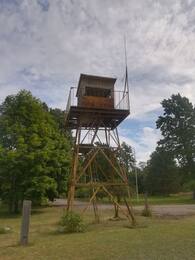Šliterės valstybinis rezervatas pasienio režimo zonoje
Buvusių Šliterės valstybinio rezervato darbuotojų prisiminimai apie sovietmetį.
Vilnis Skuja: Sovietmečiu dirbau Šliterės valstybiniame rezervate. Su pasieniečiais tekdavo susitikti dažnai, bet stengdavomės tokių susidūrimų išvengti, nes pasienio zonoje atsargos darbuotojai – vyrai su žiūronais rankose, žemėlapiu krepšyje, fotoaparatu – kiekvienam pasieniečiui liepė nedelsiant sustoti ir išsiaiškinti bylos aplinkybes. Tada sekė pasiaiškinimas, kuris paprastai trukdavo ne trumpiau nei pusvalandį. Jei spėjome laiku pastebėti pasieniečių automobilį, greitai nubėgome į mišką. Netgi turėjome šūkį: „Žalieji važiuoja!“ Tuo metu visi automatiškai kažkur pasislėpė. Jei iškildavo poreikis (pavyzdžiui, stebėti paukščių migraciją, atlikti surašymus ir pan.) eiti į paplūdimį, visada oficialiai pranešdavome į vadinamąjį paštą. Tada problemų nebuvo, nes pasieniečiai taip pat buvo protingi žmonės, nesitaikę nei su mumis, nei su kitais vietiniais gyventojais. Išimtis buvo tais atvejais, kai asmuo (vietinis ar imigrantas) buvo aštrus ir prašė bėdų.
Pasieniečiai taip pat atliko įvairių neteisėtų veiksmų. Jie nukirto medį, iškasė smėlį ar tranšėją netinkamoje vietoje. Kartą jie buvo sugauti Kolkos sąvartyne, kur neteisėtai nušovė šerną. Pasitaikydavo atvejų, kai kariuomenės samdomiems darbuotojams pavykdavo įsigyti „Kalašnikovą“, kad galėtų vykti į nelegalias medžiokles. Nors oficialiai žvejyba tarp Kolkos ir Ventspilio buvo uždrausta, pasieniečių priedangoje vietos gyventojai galėjo ne visai legaliai išplaukti į jūrą ir žvejoti. Už tokius veiksmus pasieniečiams „mokėjo kyšius“. Ir tai buvo vienintelis būdas žvejoti.
Pasieniečių postai buvo įsikūrę Kolkoje ir Mazirbėje. Vienu metu Saunagoje ir Pitrage taip pat buvo statomi forpostai kaip rekvizitas ar maketai. Naktį jūrą ir pakrantę apšvietę prožektoriai buvo prie Kolkos ir Mazirbės. Mazirbės paplūdimys veikė (vasarą) nuo 08:00 iki 22:00, apie tai perspėjo lentelė dviem kalbomis. Mazirbėje buvo vienas didžiausių paplūdimių. Likę lyvių kaimai turėjo tik nedidelius pakrantės ruožus, kuriuose buvo leista apsistoti civiliams. Devintajame dešimtmetyje net buvo kilusi mintis visoje pakrantėje statyti ištisinę spygliuotos vielos tvorą. Tam tikslui iš Šliterės rezervato jau buvo nupirkta plaušienos.
Alanda Pūļina: Kai sovietmečiu dirbau Šliterės valstybiniame rezervate, rezervato administracija buvo įsikūrusi Livonijos liaudies namuose. Prisimenu pasieniečių reidus, kur buvo sustiprinta kontrolė – pasieniečiai su bobomis rengdavo reidus ir net kelis kartus prašydavo tų pačių žmonių parodyti dokumentus. Dar turėjau tų laikų leidimą (pravažiavimą į pasienio režimo zoną). Jei į Mazirbę keliavote iš Dundagos, pasienio režimo zona prasidėjo jau Jaundangoje, kur buvo užtvara ir pasienio apsaugos postas.
Susijusios vietos
Mazirbės jūreivystės mokykla
Šiame komplekse esantis sovietinis pasienio apsaugos bokštas yra vienas geriausiai išsilaikiusių tokio tipo Latvijos pakrantėje. Deja, pastatų būklė prasta, toje vietoje yra šautuvų užtaisymo/iškrovimo aikštelė, taip pat išgelbėta įvažiavimas ir apkasų fragmentai.
Pakrančių apsaugos postas buvo įsikūręs buvusiame Jūrų mokyklos pastate. Posovietiniu laikotarpiu dalyje pastatų buvo siūlomas apgyvendinimas.
Antrasis sovietinės pasienio apsaugos bokštas yra apie 400 m nuo paplūdimio, tačiau, deja, jis yra apgriuvusios būklės. Tačiau Mazirbės laivų kapinės yra ne toliau kaip 500 m nuo paplūdimio bokšto Sīkrago kryptimi.





